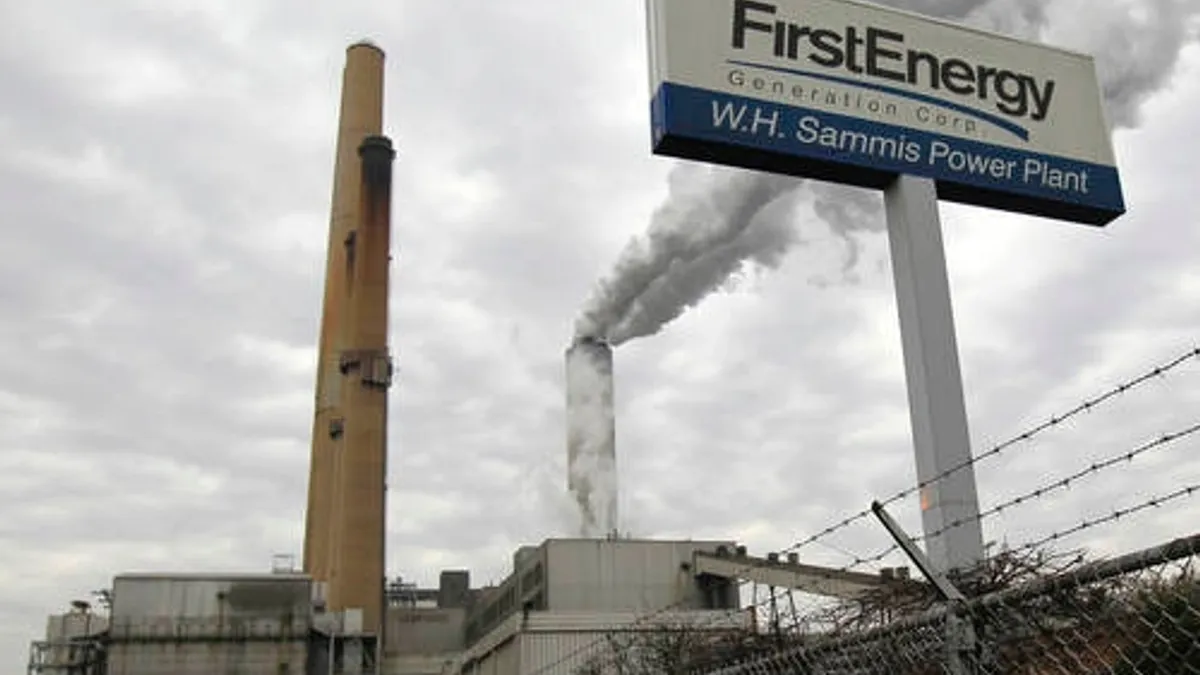Dive Brief:
- The Public Utilities Commission of Ohio has rejected a virtual power purchase agreement proposed by FirstEnergy, instead allowing the utility to recover a smaller amount of revenue through a Distribution Modernization Rider (DMR) recommended by staff.
- Regulators set the DMR at $132.5 million annually for three years, grossed up for taxes, with the possibility of a two-year extension. FirstEnergy had proposed $558 million per year for eight years.
- Officials at FirstEnergy expressed disappointment in the order, characterizing the annual DMR as $204 million, rather than PUCO's smaller figure.
Dive Insight:
The decision from the Public Utilities Commission of Ohio on Wednesday pleased no one. Consumer groups decried a "bailout" for the utility, while FirstEnergy's CEO said the DMR rider will be "insufficient to cover the necessary and costly investments" in the utility's grid.
According to the Public Utilities Commission of Ohio, the DMR rider "set at $132.5 million per year (to be grossed up for taxes annually), will provide FirstEnergy with an infusion of capital so that it will be financially healthy enough to make future investments in grid modernization."
FirstEnergy said company assumes the sum will be about $204 million annually, but that amount "fails to recognize the significant challenges that threaten Ohio utilities' ability to effectively operate."
In a statement, PUCO Chairman Asim Haque said the DMR’s primary purpose "is to ensure that FirstEnergy retains a certain level of financial health and creditworthiness so that it can invest in future distribution modernization endeavors."
The commission's decision is the latest in FirstEnergy's bid to secure support for older, struggling power plants.
FirstEnergy's initial proposal included power purchase agreements that covered the Davis-Besse Nuclear Power Station in Oak Harbor, the W.H. Sammis coal-fired plant in Stratton, and a portion of the output of Ohio Valley Electric Corporation (OVEC) units owned by its generating affiliate FirstEnergy Solutions. In total, the PPA covered 3,300 MW.
But in April, the Federal Energy Regulatory Commission rejected those agreements, rescinding affiliate waivers necessary to execute the transactions. That led FirstEnergy to decide it would sell or retire four units at the W.H. Sammis facility and file a separate proposal for regulatory support that did not include PPAs, but instead added monthly surcharges to customer bills as part of its rate plan.
The move was widely seen as a tactic to avoid further FERC review, and environmental groups criticized regulators for what they said was assisting the utility.
"[T]he Commission has aided FirstEnergy’s efforts to sidestep a recent order of the Federal Energy Regulatory Commission (FERC) that raised serious questions about FirstEnergy’s previous bailout proposal," said Shannon Fisk, an attorney at the non-profit environmental law firm Earthjustice, who argued against the proposal. "Rather than forcing customers to prop up profits for a corporation that made a bad bet on aging coal plants, the Commission should be looking after customers and ensuring investments in job-creating renewable energy, energy efficiency and smart grid initiatives.”
Consumer group The Alliance for Energy Choice issued a statement following PUCO's decision, calling the rider "bad for Ohio." Among critics' concerns, the DMR proposal did not require the the utility to spend the additional money on modernization efforts.
“The Alliance for Energy Choice continues to be disappointed that the PUCO once again granted the utility’s request for more money with no corresponding benefit to customers,” said Alliance spokesperson Todd Snitchler.
FirstEnergy said in a statement the DMR rider would raise residential consumer prices about $3 a month. Earthjustice said it plans to appeal to the Ohio Supreme Court.
This post has been updated to include statements from FirstEnergy and Earthjustice.















